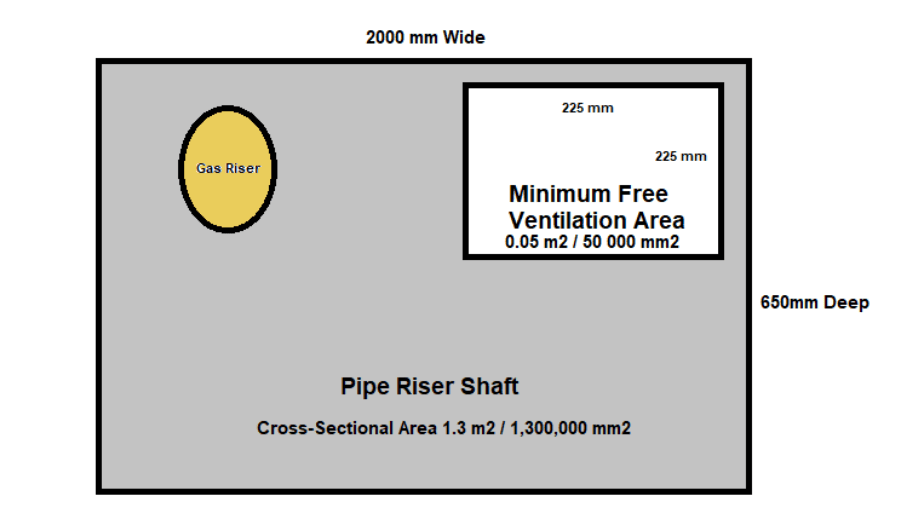Download or print a PDF of this GIS
Overview
This gas information sheet provides information about:
- what constitutes a concealed location in a high rise building[1] and the criteria it must meet to comply with the AS/NZS 5601.1:2022 Gas Installations: Part 1 General installations.
- the requirements for piping in concealed locations (other than underground or embedded in concrete) as specified in AS/NZS 5601.1:2022 Clause 5.3.8 (Table 5.3.8).
Concealed locations
Piping in a concealed location often remains undisturbed for long periods of time, which can allow leaks to go undetected. Without adequate ventilation, gas can build up to potentially dangerous levels over a period of time. Concealed locations are considered to be concealed even when accessible via an access panel or door.
There are three main types of concealed location:
- Pipe riser shafts
- Service cupboards
- Ceiling spaces
- Pipe riser shafts
Pipe riser shafts act like a chimney (referred to as stack effect or chimney effect) for leaking gas so must be designed and built to contain and vent potential gas leaks from non-permanent joints. A pipe riser shaft must be:
- sealed from adjacent areas
- well ventilated with a vent at the top and bottom of the shaft[2], and
- suitably sized floor penetrations that the pipe passes through (see the section on ‘Calculating the free ventilation area’ for information about how large these vents and penetrations must be) vented to a safe location outside the building.
Pipe riser shafts may contain equipment that must be accessible for servicing and inspection[3].
Service cupboards
A service cupboard, which is typically installed on each floor level, is an area that:
- conceals piping or equipment,
- is sealed to stop the migration of leaking gas into the building structure, and
- can be accessed via a service door.
Service cupboards must also be well ventilated when non-permanent joints are being used.
Ceiling spaces
Ceiling spaces can be difficult to ventilate and permanent joints should be used as much as possible. Ceiling spaces must be ventilated when non-permanent joints are installed.
One solution for isolating ceiling spaces that have non-permanent joints (for example, occupancy isolation valves) from the rest of the ceiling is to install a sealed box (with an access hatch incorporating a vent into the space below) to enclose the non-permanent joints.
See the section on ‘Calculating the free ventilation area’ for information about how large ceiling space and service cupboard vents must be.
What is required when operating pressures exceed 7 kPa?
When the operating pressure exceeds 7 kPa:
- pipe riser shafts, service cupboards, and ceiling spaces must all be ventilated (as already described)
- all piping joints must be permanent and the number of joints kept to a minimum
- piping must be accessible.
What is ‘accessibility’?
Accessibility generally refers to a location with sufficient clearances to allow access to, and removal of, all serviceable components.
In this case, it means that pipes and services can be accessed via a ceiling hatch or a sub-floor door, or are otherwise viewable and accessible on each floor of a high rise building.
Calculating the free ventilation area
The free ventilation area refers to the size of an opening for ventilation or a physical vent and is:
calculated using AS/NZS 5601.1:2022, Table 5.3.12
based on the cross-sectional area of the pipe riser shaft, service cupboard, void, duct, box or sleeve being ventilated.
For example: for a pipe riser shaft with a cross-sectional area between 0.05 and 7.5 square metres, the minimum free ventilation area of each opening must be no less than 0.05 square metres or 50 000 square millimetres (e.g. 225mm x 225mm opening).
Ventilation openings or physical vents must always be sized to provide the minimum required free ventilation area. Ventilation openings must also comply with the requirements of AS/NZS 5601.1:2022, Clause 5.3.12.
Diagram 1: Example – Plan view of a pipe riser shaft with minimum free ventilation area provided at the base.

What is a permanent joint?
This is a joint that cannot be easily disassembled. Examples include brazed, welded, crimped, and hydraulically or mechanically compressed joints. (See AS/NZS 5601.1:2022, Clause 1.3.86.)
The use of a quick-setting thread compound is not considered to be a permanent jointing method.
Equipment installed in concealed locations
The installation of equipment (or other) in a pipe riser shaft, service cupboard or ceiling space that meets the definition of an ignition source (see AS/NZS 5601.1:2022 Clause 1.3.65) is not recommended. If this type of equipment is planned for installation, then a Hazardous Area assessment must be carried out by an appropriate competent person to support the installation of such equipment, in the concealed location.
*Ignition sources are a source of energy sufficient to ignite a flammable mixture and includes, but is not limited to, flames, incandescent material, electric sparks, hot surfaces and mechanical impact sparks not suitable for use in hazardous locations.
[1] A building with five or more storeys above ground level.
[2] Unless the pipe joints are permanent and the number of joints is kept to a minimum.
[3] This includes pressure regulators, limited flexibility connections, isolation valves, pipe anchors, and spring clips.
Date: 13/09/2025 0:10
Controlled document
The currency and accuracy of this document cannot be guaranteed once printed or saved to a storage device. If in doubt, please check the ESV website for the current version.
Reviewed